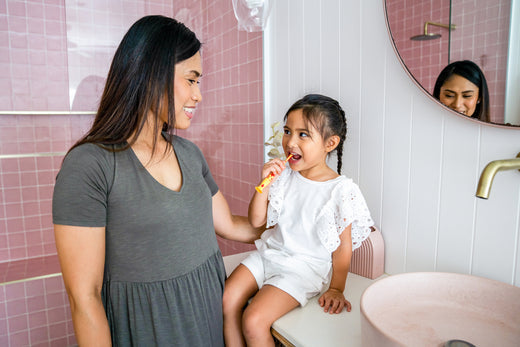
Baby teething is an exciting time for parents, as this means your child will soon be ready for solid food! However, as their baby teeth emerge, this stage of growth and development may cause some discomfort for the infant and even concern for the parents. Read on to:
- Know the signs and symptoms of baby teething
- Deal with common baby teething issues
- Try home remedies to help soothe your child’s tender gums
- Take better care of baby teeth
There is no greater thrill than seeing your child hit their anticipated milestones— their first smile, first words, and first steps. But a few growth phases can also be uncomfortable, such as baby teething or odontiasis. The more you know about baby teeth growth, the better you can prepare as a parent to help your child deal with the pain and discomfort during this time.
-
Overview
-
Baby Teeth Growth: What's It All About?
-
What You Need to Know About Baby Teeth Growth
-
Handling Baby Teeth Growth Like a Pro!
- Frequently Asked Questions on Baby Teeth Growth
Baby Teeth Growth: What's It All About?
Teething is when your baby’s teeth start to work their way through the gums, which usually occurs when your baby is between six and 12 months old¹. Understandably, your baby may experience some discomfort as their teeth push out. As parents, you can also expect a few sleepless nights as you soothe a frustrated, teething baby.
To help relieve the pain that your baby may experience during this phase of baby teeth growth, it’s important to help them maintain proper dental health. Taking care of your child’s teeth is important, as their first set paves the way for their adult teeth to develop later on. If baby teeth are removed or decay too early, your paediatrician may refer you to a dentist so that treatment can be performed immediately.

What You Need to Know About Baby Teeth Growth
Here’s what to expect during this important baby teething age and how you, as a parent, can make this transition as comfortable as possible.
-
Baby teeth will develop during their first year
Baby teething usually occurs when the baby is between six and 12 months old. However, it’s important to note that each child develops at their own pace, so teething may occur even at a later time. If there’s a delay, there's no need to panic; check in with your paediatrician for any concerns.
When it comes to baby teeth growth, the first teeth to appear are usually the two bottom front teeth, also known as the central incisors. After a few weeks, the four upper front teeth (the central and lateral incisors) emerge. Next to erupt are the lower lateral incisors flanking the two bottom front teeth. After one year, the first molars, or back teeth, will begin to develop.
-
Drooling and increased chewing are telltale baby teething signs
Baby teething signs and symptoms are unique to each child. But the first signs are often increased spitting and drooling, especially during this phase of baby teeth growth. You may also notice your child chewing or gnawing on hard objects to soothe their gums. Other babies might also experience periods of crankiness, which often result in prolonged crying, sleepless nights, and disrupted eating patterns3.
In some cases, baby teething can be painless. But others may develop tender or swollen gums. This can be due to the accumulation of germs in the new break around the gum area. Gum pain may also slightly elevate your child’s temperature. But don’t worry, because this is normal.
However, if your baby’s health escalates to a high fever with diarrhoea or a runny nose, contact your doctor at once. This might be related to a virus rather than teething. Babies may occasionally develop a low-grade fever in response to the teething process. If the fever persists or is accompanied by other symptoms, seek immediate medical attention.
-
Alleviate teething issues and pain with cold remedies
If your baby is experiencing swollen gums due to baby teeth growth, you can help ease their pain by putting something cool in their mouth. This can be a clean, wet washcloth, a chilled spoon, or a cooled teething ring, to soothe their tender gums.
You may also opt to massage the baby's gums with clean fingers. Often, a teething baby will want to chew more. Offer the baby solid, refrigerated teething toys to keep them occupied. But avoid teething toys that have liquid inside because these might break or leak. If you’re trying teething biscuits, don’t leave the baby unattended. This is because the baby might choke on the smaller pieces. Moreover, refrain from feeding your child if they’re not consuming solid food yet. If all else fails, ask your doctor if they may prescribe medication such as ibuprofen, which can help provide much-needed relief during this phase of baby teeth growth.
-
Avoid homoeopathic teething tablets and topical gels
Don’t use baby teething tablets that contain belladonna (a plant poison) and benzocaine, which can cause harmful side effects for your baby. Although these have the potential to numb the pain, the Food and Drug Administration bly disapproves of the use of these products4.
In addition, amber teething necklaces should be avoided. They are considered a choking hazard and your baby can be accidentally strangled by the necklace. In addition, there’s no significant research to support its effectiveness5.
-
Use fluoride modalities
Fluoride is a mineral that hardens the enamel of teeth, preventing tooth decay in the process. It is not only found in toothpaste but also in tap water and other supplements that you can add to your child’s diet6. At six months, when your baby is starting to eat solids, give them a few ounces of water in a sippy cup. If approved by your paediatrician for use during this phase of baby teeth growth, fluoride supplements such as tablets and drops can be taken daily to maximise benefits. Always consult your doctor.
-
Brush your child’s teeth twice a day
To prevent baby teething issues, brush your child’s teeth with water and fluoridated toothpaste. If your child is three years old and can already spit, it’s acceptable to use a little more toothpaste7. If they’re not of age, a pea-sized amount or smaller should be fine. Always help your child properly brush their teeth because there’s a chance that they may swallow the toothpaste. Toothpaste can be harmful, especially in large doses.
Remember to brush the child's teeth at least twice a day, after meals. Seek the advice of your paediatrician if your child can also start flossing early on. Usually, flossing is done when two teeth start to touch. Additionally, avoid letting your child go to bed with a sippy cup. Milk can accumulate in their mouth, causing plaque and other unwanted teeth issues.
-
Make a dental appointment as soon as baby teeth growth begins
After the first eruption of teeth or when your baby is nearing 12 months, seek dental care for your child. A paediatric dental checkup can ensure that your baby’s teeth are developing normally. And if there are problems, your doctor can help resolve them immediately. Taking care of their baby teeth ensures that there is ample space for the adult teeth to grow. If you notice anything unusual, consult an expert to rule out any other underlying conditions not related to teething.
Handling Baby Teeth Growth Like a Pro!
The baby teeth growth and development stage can be exciting and, at the same time, very challenging for parents. It’s hard to see your child in pain, but remember that baby teething symptoms are normal and part of your baby’s teeth development. When you can, try easy home remedies to help alleviate the discomfort. If symptoms persist, consult your paediatrician and schedule regular checkups with your dentist. Remember, if you take care of your child's baby teeth, it will lay the foundation for their adult teeth when they grow older.
Looking for more tips on baby teeth growth? Join the Enfamama A+ Club and get free advice, latest promotions, try FREE samples, and more from our community.

Frequently Asked Questions on Baby Teeth Growth
We know you may have a lot more questions, so we’ve compiled some of the most commonly asked about baby teeth growth.
1. When will my baby have their full set of teeth?²
Your baby’s first teeth will come in gradually as early as 6 months old, and their first set of primary teeth - typically 10 at the top and 10 at the bottom - will be complete when they’re three years old.
2. When should my baby start seeing a dentist?⁷
In the same way that you should regularly schedule a checkup with your paediatrician, so should you with a paediatric dentist. It is recommended that you schedule a consultation with a dentist for your child by the time they are a year old or six months after their first tooth erupts.
3. Why aren’t pain relievers that are applied to sore baby gums recommended?⁶
These types of pain-relieving medications, which are rubbed onto your baby’s gums, don’t do much to soothe pain and discomfort. While they can be applied directly to the gums, it's important to note that these remedies may also be easily washed away due to your baby's excessive drooling. Moreover, the medication's numbing components might damage your baby's throat and affect how they swallow. It is recommended to avoid these and discuss other options with your doctor.
Related articles:
- Baby's First Food: Everything You Need To Know
- How to Ensure Proper Nutrition When Your Child Is a Fussy Eater
- How To Introduce Solid Foods to My Baby
- Your Baby's Digestion: 5 Things Mothers Need To Know
- Different Types of Baby Cries
Expert Resource:
Dr. Raymond Choy Wai Mun
(MCR 18097A)
MBChB (UK), Aviation Medicine (Singapore)
References:
- Baby teething symptoms (n.d.). Retrieved Aug 4, 2020 from: https://www.nhs.uk/conditions/pregnancy-and-baby/teething-and-tooth-care.
- Teeth Eruption Timetable (n.d). Retrieved Aug 4, 2020 from: https://my.clevelandclinic.org/health/articles/11179-teeth-eruption-timetable.
- Teething: Tips for soothing sore gums (n.d). Retrieved Aug 4, 2020 from: https://www.mayoclinic.org/healthy-lifestyle/infant-and-toddler-health/in-depth/teething/art-20046378.
- FDA warns consumers about homoeopathic teething products (n.d). Retrieved Aug 4, 2020 from: https://www.fda.gov/drugs/information-drug-class/fda-warns-consumers-about-homeopathic-teething-products.
- Teething Necklaces and Beads: A Caution for Parents (n.d). Retrieved Aug 4, 2020 from: https://www.healthychildren.org/English/ages-stages/baby/teething-tooth-care/Pages/Amber-Teething-Necklaces.aspx.
- HealthyChildren.Org : Teething and Tooth Care. American Academy of Paediatrics. 2023 https://healthychildren.org/English/ages-stages/baby/teething-tooth-care/Pages/default.aspx.
- Teething Tots (2018). Retrieved Aug 4, 2020 from: https://kidshealth.org/en/parents/teething.html.



